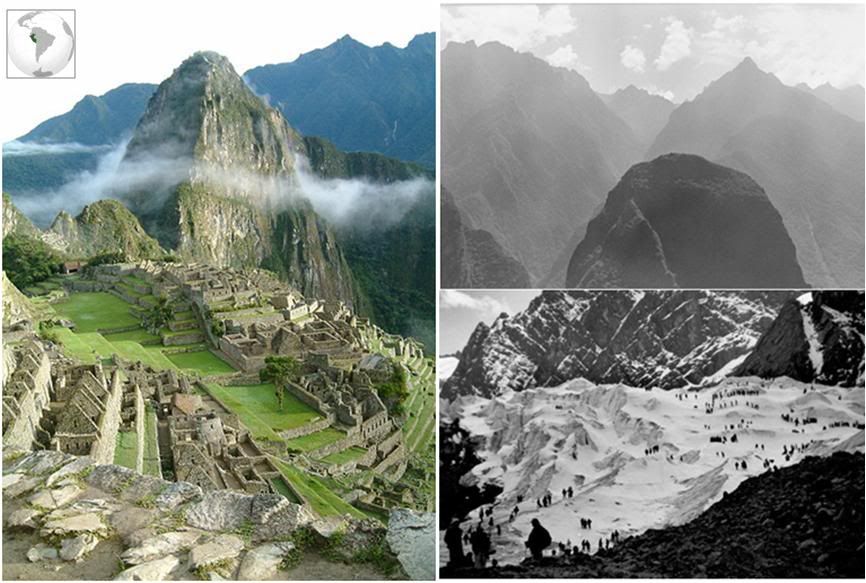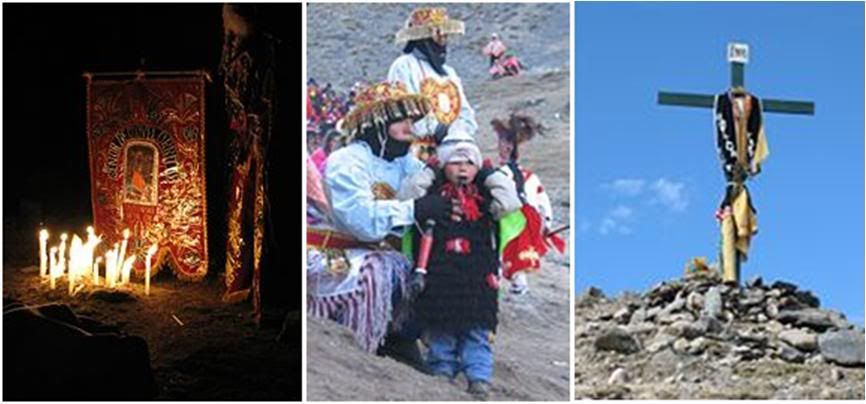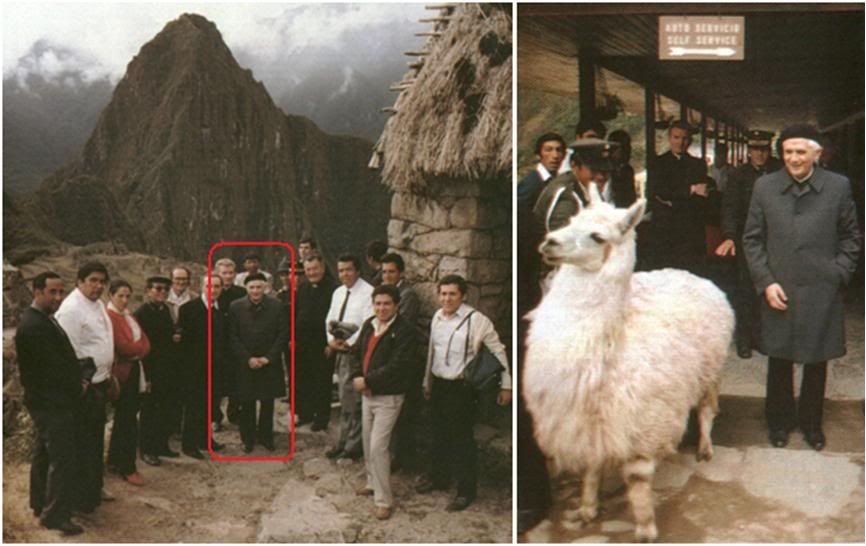 The fabled city of Machu Picchu, and not far from it, the mountain glacier area that is the center for a fascinating Catholic folk festival.
High in the Andes, Peruvians mark
The fabled city of Machu Picchu, and not far from it, the mountain glacier area that is the center for a fascinating Catholic folk festival.
High in the Andes, Peruvians mark
Christ's appearance to shepherd boy
By Barbara J. Fraser

OCONGATE, Peru, June 26 (CNS) -- At the end of an all-night procession, several thousand pilgrims in colorful garb gathered on a hilltop in this remote corner of the Andes, waiting for dawn. As the sky brightened behind an eastern mountain peak and light swept along the ridge, a tall young man sounded a long, plaintive note on a conch horn.
The sun burst over the Andes and Quechua-language prayers floated over the frosty fields. Melodies rose from wooden flutes and drums played by musicians with weathered faces.

The assembly broke into smaller groups, dancing down the mountain in colorful columns that snaked and twined, celebrating the new day and the end of a pilgrimage that drew some 60,000 people.
At the bottom of the hill, Jesuit Father Luis Herrera waited in a rustic adobe chapel, where a solemn procession arrived, carrying images of Jesus and Mary. Father Herrera prayed with the group, bringing the nearly weeklong pilgrimage to a close. If God wills it, he said, they will gather there again next year.

The festival of the Lord of Qoyllur Rit'i, marking Christ's appearance to a young shepherd boy and coinciding with the full moon nearest to the feast of the Body and Blood of Christ, dates to the 1780s, though its roots probably go back further. Like many religious traditions, it has evolved over the centuries, but it is now threatened by tourism, global warming and simple economics.
"We do this out of faith," said Adolfo Quispe, 23, leader of a group of 18 young dancers who set out from their hometown of Chincheros, near the tourist mecca of Cuzco, four nights earlier, June 6. "We are faithful Catholics who believe in Jesus Christ, who has blessed us in many ways."
During the pilgrimage to the sanctuary of the Lord of Qoyllur Rit'i, he and the other dancers thanked God for those blessings and made a promise of faith for the coming year. Setting out before dawn June 7, they hiked five miles up a valley, where llamas and alpacas grazed along a stream fed by glacial meltwater.
At the top of the valley, more than 14,000 feet above sea level near the foot of a glacier, they quickly set up camp and changed into traditional garb. For the next three days, Andean melodies rang out day and night as hundreds of groups of young people dressed in traditional costumes followed the same steps performed by generations of pilgrims before them.
The Jesuit priests who work in the highlands around Cuzco and have celebrated liturgies in the Qoyllur Rit'i sanctuary for decades say the modern world is infringing on local traditions.
"The nature of the fiesta has changed," Father Herrera said. "It is no longer a celebration of llama and alpaca herders."
Father Antonio Sanchez-Guardamino, a Jesuit from Spain's Basque region and pastor in the town of Ocongate, recalled that in the early 1980s, when he began celebrating liturgies at Qoyllur Rit'i, most of the confessions he heard were in the local Quechua language. Now, he said, 85 percent are in Spanish.
While the fiesta originally drew mainly farm families from the remote highland villages, it now attracts pilgrims who have migrated from the countryside to towns in search of employment or education.
The dancers from Chincheros are among those who remain faithful even though they live in town. For three days, they stop only to eat and to sleep for an hour or two before the trio of musicians rouses them with a melody. They dance in the sanctuary before an image of Jesus on a rock that marks the spot where Christ appeared, then dance uphill to a small chapel dedicated to Mary and down toward the sanctuary again in a ring of color and melody.
The sanctuary bell tolls several times a day, and more than 2,000 pilgrims jam into the church, standing elbow to elbow, for a liturgy in Spanish and Quechua. At this altitude, nighttime temperatures drop below zero, but the sanctuary is warmed by body heat and the banks of candles lit by pilgrims. There are no shelters for sleeping, so a few pilgrims pitch tents, while many more huddle under wool blankets and sheets of blue plastic sold by enterprising vendors.
The fiesta has become more commercial in recent years. When Eugenio Huaman, 46, first made the pilgrimage 25 years ago, people carried everything they would need -- a blanket and scant food rations -- in bundles on their backs. Now vendors sell everything from sunglasses to holy cards to full meals. Money-changers exchange dollars, euros and Peruvian currency.
The night of June 8, fireworks burst overhead while dancers and musicians filled the plaza outside the sanctuary, a concrete square below the church and the areas in front of the Marian chapel. Thousands of pilgrims prayed or watched the dancing.
In the middle of the night, columns of men dressed in shaggy robes representing bears or black alpacas slipped away by moonlight and climbed for several hours over narrow, rocky trails to glaciers high on the mountain walls. The men, known as "pablos," play a special role during the fiesta, and their pilgrimage to the ice is a high point of the celebration.

In the past, they hacked blocks of ice off the glacier and carried them down to the sanctuary at dawn as an offering to the Lord of Qoyllur Rit'i. It was a point of pride to take the largest blocks possible, despite the discomfort of the frigid loads on their backs. They then carried the ice home to their villages, a sign of the gift of life.
Glaciers in the Peruvian Andes are retreating rapidly, raising the prospect of water shortages during the annual dry season. This year, the pablos were prohibited from carving ice blocks from the glaciers, although some people returned with small chunks of ice or bottles filled with slush.
Scientists say the glaciers could be gone in another 20 years, and Father Sanchez-Guardamino said he worries about what will happen to high-mountain herders if the glaciers disappear. Meltwater flowing from the ice fields forms braided streams that merge to flow past the sanctuary, down the valley and into the Vilcanota River, sustaining pastureland for alpacas.
Father Sanchez-Guardamino said he is also concerned about water pollution, especially after tens of thousands of pilgrims have camped for three days in the valley, which has virtually no infrastructure, and have left tons of trash and waste. The local government now provides a few latrines and trash cans, but all waste must be packed out on horses.
Although changes in the fiesta are inevitable, Father Sanchez-Guardamino said the pilgrims' faith remains firm. Nevertheless, he urges people to nurture their faith throughout the rest of the year.
"It is obvious that people live and breathe faith and devotion" at Qoyllur Rit'i, he said, "but if this is not lived out, (the fiesta) will just become a tourist attraction and a show. If the devotion is not accompanied by a life of mercy, help for one's neighbor, truth above all else, and justice, it will be empty -- it will one day be just folklore, with no meaning."
Finally, I have an excuse to use these pictures of Cardinal Ratzinger in Machu Picchu way back in 1987, when he travelled to Peru with his then secretary Mons. Josef Clemens. In the left photo, he makes the acquaintance of a llama, the wool-bearer of the Andes. I am sure the cardinal would have been told all about Qoyllur Rit'i.

[Modificato da TERESA BENEDETTA 06/07/2009 04:50]